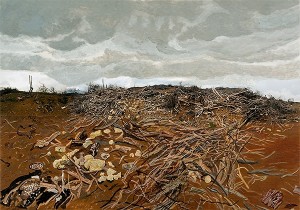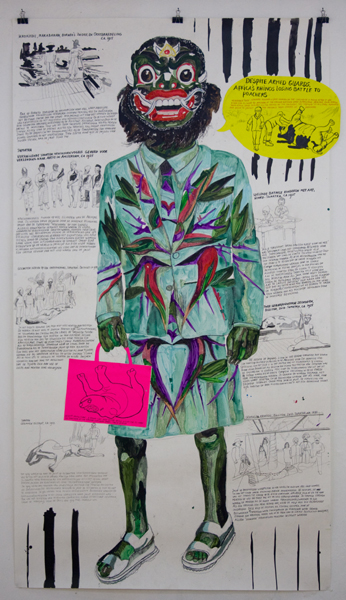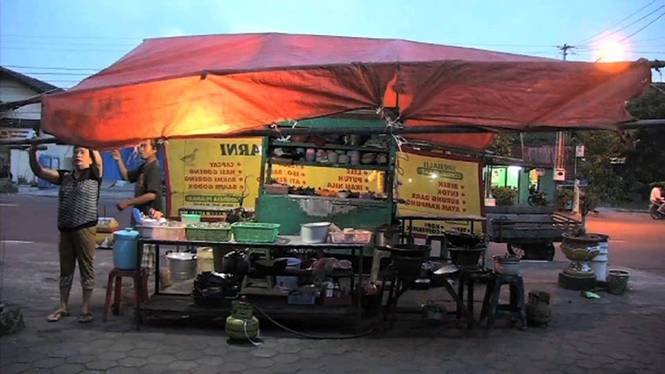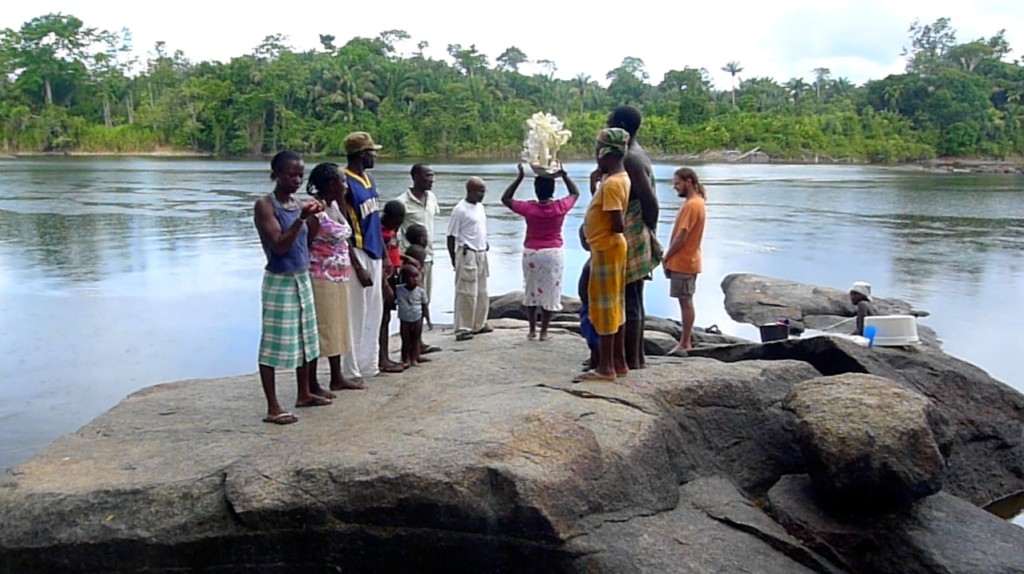
Group exhibition with Yasser Ballemans, Wouter Klein Velderman, Charlotte Schleiffert, Lydia Schouten, Berend Strik, Su Tomesen en Jolijn de Wolf.
CBK Zuidoost Amsterdam, from August 21 till October 18.
Plantage Wechi, 2010.
WANDERLUST
“Travel is fatal to prejudice, bigotry and narrow-mindedness” (Mark Twain)
Central to the exhibition is the importance and influence travel has on artists and their work. Most of the selected artists wander(ed) to a great number of countries, for shorter or longer times, supported by the Mondriaan Foundation or on their own merits. There is always that strong desire and impulse to travel and explore the world, to learn and be inspired. They continuously expand their art practice by applying their encounters, experiences, new insights and knowledge, acquired while wandering, in their work and/or work methods.
 Carrus Navalis, 2012.
Carrus Navalis, 2012.
Yasser Ballemans went to Institute Buena Bista in Curacao in the carnival period and engaged with carnival as sculptural and cultural manifestation. He is interested in the relationship between the identity of the individual participant and the disappearing into the mob. He continued this research and it has become a continuous theme in his work. Yasser Ballemans works with sculpture, installation and performance. Ballemans works are physical manifestations of a highly negotiable reality. Is the sculpture more real than the model of the sculpture? Is the body, in its carnival-posture and temporary outfit, less real in its claiming a new identity and new roles that are different from our everyday habits? www.yasserballemans.nl
 Charlotte Schleiffert, Despite Armed Guards, 2013.
Charlotte Schleiffert, Despite Armed Guards, 2013.
Travel is an ongoing well of inspiration for Charlette Schleiffert’s choice of subject and materials as is shown in the works made in Indonesia where her figurines wear masks as we know them from the Indonesian traditional performing arts as she comments in text on international news events and their impact. Charlotte Schleiffert life-size figures in her drawings and paintings are fertile soil for Charlotte Schleiffert’s fantasy, based on power and suppression. Besides the fact that passionate women are central in her work, she feels committed to the social and political movements of our global society in general. “Schleiffert’s area of interest comprises outspoken physical figures and human impulse. She does not subdue this drive with gentle amorousness nor does she eroticize. Her topics serve her expressive capacities, as she pursues the right painting with intellect and fury.”(W.A.L. Beeren).Her work is raw and sensual, direct without hypocrisy. It is suggestive, balancing between abstract compositions and figurative forms. www.charlotteschleiffert.com
Lydia Schouten while reading the book “Zoutrif” by Miriam Sluis explored Curacao with a machete looking for old plantation mansions that found their way into her work. Lydia Schouten is a multimedia artist, performer and video artist. Schouten’s work can be divided into three periods: an exploration of performance art from 1978 to 1981; a period of work in video from 1981 to 1988; and since then, an ongoing interest in installation, often combining video, sound, photographic components and drawing. In all three periods certain thematic elements are apparent at Schouten’s work. Femininity, isolation and the relation of mass media with sex and death are a few of the most frequent ones. www.lydiaschouten.com
 Homeless people living in Yogyakarta cemetary, 2013.
Homeless people living in Yogyakarta cemetary, 2013.
Berend Strik found in Indonesia the excitement, passion and curiosity for the arts that he feels has been missing in Europe lately. It relit his fire and his own passion for making art and he became actively involved in the western discourse about contemporary art in non – western settings and their importance. Berend Strik prefers the word “stitching” over “embroidery” in reference to his own practice; for Strik, the latter is necessarily image-based, whereas the former simply refers to attaching one material on top of another. Strik makes c-prints of photographs he takes during his travels, and then highlights parts of the compositions by sewing fabric onto the images. In his words, he uses “stitching to make part of the photographs more physical.” By perforating them with a needle and thread, the two-dimensional quality of the image is disrupted, creating a work that is both tactile and conceptually driven. www.berendstrik.com
 Warang Makan Kakilima, 2012.
Warang Makan Kakilima, 2012.
Su Tomesen met her Javanese husband and divides her time between the Netherlands and Indonesia: “My speed of working decelerated. When doing a residence of three or four months it’s like being in a rice cooker, right now I have a lifelong relationship with a place.” Su Tomesen is a visual artist working in the media video, photography and installation. Most of her work evolves from traveling, and immersing herself in urban (sub) cultures. A recurring theme in her socially involved work is expressions of ingenuity and human resourcefulness in public space. Her previous education as a historian, and work as a director and researcher for television, is integrated in her art practice. She has been fortunate to see a lot of the world as artist-in-residence on various continents. She considers herself a type of cross-cultural ambassador when showing works she realized elsewhere in the world; for example, exposing an audience in Amsterdam to an installation from Amman, presenting her videos from Johannesburg in Yerevan, or giving artist talks wherever she goes. www.sutomesen.nl
 Lang Sculpture, 2014.
Lang Sculpture, 2014.
Wouter Klein Velderman sculptures where all conceived by his own hands. While in residence at Tembe Art in Moengo, Suriname he found himself expanding to trust others as decision makers. Working with a group of people accelerated his work into bigger site specific projects that involve workers, volunteers and collaborators. Wouter Klein Velderman uses materials and themes for his sculptures and installations that often have an industrial-like character. Metal, PVC-canvas and wood are the ingredients to depict matters like transport, mobility and storage. Even though their subjects tend to have an industrial character, the sculptures have quite an opposite feeling to them: vulnerable, delicate, and refined. By treating the harsh, impersonal materials endlessly, with great care and tenderness, the sculptures come into contrast with their subject. A huge pile of wood waste in the jungle of Surinam could result into the tallest Mickey Mouse sculpture of South America that somehow becomes a functional object. www.wouterkleinvelderman.nl
 Thanksgiving 2, 2011.
Thanksgiving 2, 2011.
Jolijn de Wolf’s stay at ARTCEB in the Amazon jungle in Suriname felt like an awakening, it forced her to think about her art practice and became a more conscious artist looking for an honest and mindful connecting between the viewer and her. Jolijn de Wolf investigates the connection between the self, the others and the universe. She emphasizes on the use of our intuition in this process. Our intuition often seems to be heavily overruled by our rational thoughts. Therefore we forget this amazing skill we have: the ability to connect to each other and the world around us. What would happen if we would allow ourselves to connect? de Wolf tries to capture this process of connecting or disconnecting by freezing a moment in time. Materializing inner processes by making an image. Making an image of this blissful state we can be in when we are totally connected. Or how alone and lost we can feel when we are disconnected. Capturing the consciousness we need to understand life and to live it fully. Wolf continued working in nature in remote places and after Surname spend extensive time in Iceland. www.jolijndewolf.com
http://www.cbkzuidoost.nl/contacts/
This exhibit is in part made possible by: Stadsdeel Amsterdam Zuidoost.
Curated by Sasha Dees.
Thanks to: Tirzo Martha / IBB; Marcel Pinas / Tembe Art Studio; Mella Jaarsma / Cemeti Art House; Rob Knijn / Heden; Rinaldo Klas, Ada Korbee, Mayke Jongsma / Mondriaan Foundation.
Sasha Dees (Amsterdam/New York) lives and breaths wanderlust. Dees is an independent curator / cultural producer working on international collaborative or exchange projects. Her focus is on emerging interdisciplinary artists that push boundaries. With her projects she creates a dialogue that offers a new perspective. www.sashadees.com
Instituto Buena Bista (IBB) The residency programs (AIR, IPS and the local residency) at the Instituto Buena Bista Curacao Center for Contemporary Art are created to challenge the visiting artists to get out of their comfort zone and to step into an experimental creative wild ride. The rural and basic context of the island defies al the structures and systems the artists are used to. The challenge will manifest itself starting in the way they communicate their concepts to the students and the public, the limitations of available materials and the context available for the presentation of their works. http://www.mondriaanfonds.nl/Aanvragen/item/IBB/Buitenland_ateliers/
Cemeti Art House gives artists the opportunity in their work processes to undertake research, experiment and eventually collaborate. The residency activities will be divided into several phases: an orientation and an introduction, a work period and a final presentation. The artists get connected to diverse arts communities in Yogyakarta and interaction with the public and contribution to the art discourse are important in this programme.
http://www.mondriaanfonds.nl/Aanvragen/item/cemeti_art_house/Buitenland_ateliers/
ARTCEB functions as a laboratory where participants are encouraged to experiment with technical and artistic possibilities to develop new work. The participants are expected to work with the highest possible degree of independence. Artists from all over the world are welcomed to the opportunity to encounter this inspiring environment in all its essence and experience working in primeval forests. ARTCEB is located in Botopasi located at the Suriname River near the Amazon rainforest.
Tembe Art Studio welcomes artists of all disciplines to apply for a residency at the Tembe Art Studio. For a period of 1 to 3 months the AiR will complete its project in the district of Marowijne. Artists will be greatly impressed and inspired by the wealth of natural and cultural resources of Suriname. The artists who are visiting Moengo use the time they spend there for inspiration and reflections. They get their inspirations from the nature and culture. Moengo is neither a city nor a village and has other ways of living than many are accustomed to. This encourages creativity. The place Moengo is a natural tranquility, which is unprecedented for city dwellers and is therefore an ideal place for reflection. http://www.mondriaanfonds.nl/Aanvragen/item/Tembe_Art_Studio/Buitenland_ateliers/
